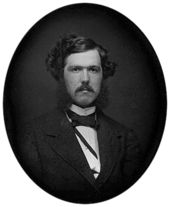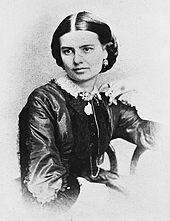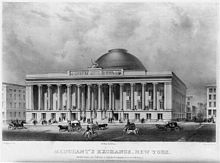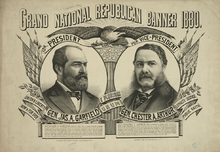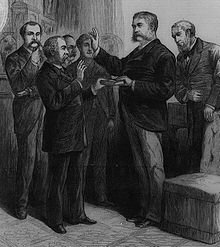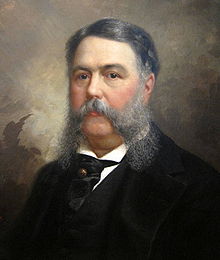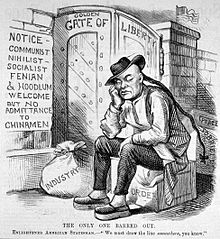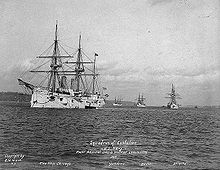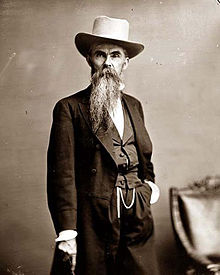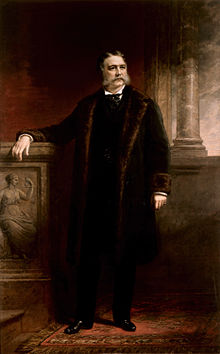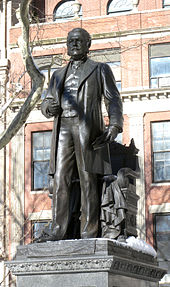
Chester A. Arthur
Did you know...
This Schools selection was originally chosen by SOS Children for schools in the developing world without internet access. It is available as a intranet download. Do you want to know about sponsoring? See www.sponsorachild.org.uk
| Chester A. Arthur | |
|---|---|
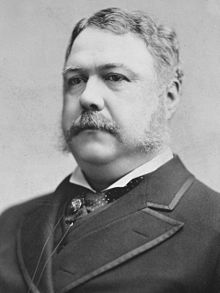 |
|
| 21st President of the United States | |
| In office September 19, 1881 – March 4, 1885 |
|
| Vice President | None |
| Preceded by | James A. Garfield |
| Succeeded by | Grover Cleveland |
| 20th Vice President of the United States | |
| In office March 4, 1881 – September 19, 1881 |
|
| President | James A. Garfield |
| Preceded by | William A. Wheeler |
| Succeeded by | Thomas A. Hendricks |
| 21st Collector of the Port of New York | |
| In office 1871–1878 |
|
| Appointed by | Ulysses S. Grant |
| Preceded by | Thomas Murphy |
| Succeeded by | Edwin Atkins Merritt |
| Personal details | |
| Born | October 5, 1829 Fairfield, Vermont |
| Died | November 18, 1886 (aged 57) New York City |
| Resting place | Albany Rural Cemetery Menands, New York |
| Political party | Republican (1854–1886) |
| Other political affiliations |
Whig (Before 1856) |
| Spouse(s) | Ellen Herndon (1859–1880; her death) |
| Children |
|
| Alma mater |
|
| Profession |
|
| Religion | Episcopal |
| Signature | |
| Military service | |
| Allegiance |
|
| Service/branch | Union Army |
| Rank | Brigadier general |
| Unit | New York Guard |
| Battles/wars | American Civil War |
Chester Alan Arthur (October 5, 1829 – November 18, 1886) was the 21st President of the United States (1881–85). Becoming President after the assassination of President James A. Garfield, Arthur struggled to overcome suspicions of his beginnings as a politician from the New York City Republican machine, succeeding at that task by embracing the cause of civil service reform. His advocacy for, and enforcement of, the Pendleton Civil Service Reform Act was the centerpiece of his administration.
Born in Fairfield, Vermont, Arthur grew up in upstate New York and practiced law in New York City. He devoted much of his time to Republican politics and quickly rose in the political machine run by New York Senator Roscoe Conkling. Appointed by President Ulysses S. Grant to the lucrative and politically powerful post of Collector of the Port of New York in 1871, Arthur was an important supporter of Conkling and the Stalwart faction of the Republican Party. In 1878 the new president, Rutherford B. Hayes, fired Arthur as part of a plan to reform the federal patronage system in New York. When James Garfield won the Republican nomination for President in 1880, Arthur was nominated for Vice President to balance the ticket by adding an eastern Stalwart to it.
After just half a year as vice president, Arthur found himself, unexpectedly, in the executive mansion. To the surprise of reformers, Arthur took up the reform cause that had once led to his expulsion from office. He signed the Pendleton Act into law, and enforced its provisions vigorously. He won plaudits for his veto of a Rivers and Harbors Act that would have appropriated federal funds in a manner he thought excessive. He presided over the rebirth of the United States Navy but was criticized for failing to alleviate the federal budget surplus that had been accumulating since the end of the American Civil War. Suffering from poor health, Arthur made only a limited effort to secure renomination in 1884; he retired at the close of his term. As journalist Alexander McClure would later write, "No man ever entered the Presidency so profoundly and widely distrusted as Chester Alan Arthur, and no one ever retired ... more generally respected, alike by political friend and foe." Although his failing health and political temperament combined to make his administration less active than a modern presidency, he earned praise among contemporaries for his solid performance in office. The New York World summed up Arthur's presidency at his death in 1886: "No duty was neglected in his administration, and no adventurous project alarmed the nation."
Early life
Birth and family
Chester Alan Arthur was born October 5, 1829, in Fairfield, Vermont. His father, William Arthur, was born just outside the village of Cullybackey, County Antrim, Ireland, and emigrated to Dunham, Lower Canada (in present-day Quebec) in 1818 or 1819 after graduating from Belfast College. Arthur's mother, Malvina Stone, was born in Vermont, the daughter of George Washington Stone and Judith Stevens. Malvina's family was primarily of English descent, and her grandfather, Uriah Stone, fought in the Continental Army during the American Revolution. Arthur's mother met his father while he was teaching at a school in Dunham, just over the border from her native Vermont, and the two soon married in Dunham, Missisquoi, Quebec, Canada on April 12, 1821. After their first child, Regina, was born in Dunham, the Arthurs moved around Vermont in quick succession to Burlington, Jericho, and Waterville, as William moved to jobs with different schools. In Waterville, William Arthur departed from his Presbyterian upbringing and joined the Free Will Baptists, spending the rest of his life as a minister in that sect. He also became an outspoken abolitionist, which at times made him unpopular with parts of his congregations and contributed to the family's frequent moves. In 1828, the family moved again, to Fairfield, where Chester Alan Arthur was born the following year. He was named "Chester" after Chester Abell, the physician and family friend who assisted in his birth, and "Alan" after his paternal grandfather. After Arthur's birth, the family remained in Fairfield until 1832, when the elder Arthur's profession took them on the road again to several towns in Vermont and upstate New York, finally settling in the Schenectady area.
William Arthur's frequent moves would later form the basis for accusations that Chester Arthur was not a native-born citizen of the United States. After Arthur was nominated for Vice President in 1880, his political opponents suggested that he might be constitutionally ineligible to hold that office. A New York attorney, Arthur P. Hinman, apparently hired by his opponents, explored rumors of Arthur's foreign birth. Hinman initially alleged that Arthur was born in Ireland and did not come to the United States until he was fourteen years old, which would make him ineligible for the Vice Presidency under the United States Constitution's natural-born citizen clause. When that story did not take root, Hinman spread a new rumor that Arthur was born in Canada, but this claim also failed to gain credence.
Education
Arthur spent some of his childhood years living in Perry and Greenwich, New York. During his time at school, his first political inclinations were to support the Whig Party, and he joined other young Whigs in support of Henry Clay, even participating in a brawl against those students supporting James K. Polk. He also showed his support for the Fenian Brotherhood by wearing a green coat. Arthur enrolled in Union College in 1845 where he studied the traditional classical curriculum. As a senior there in 1848, at age 18, he was elected to Phi Beta Kappa and was president of the debate society. During his winter breaks, Arthur taught school in Schaghticoke.
After graduating, Arthur returned to Schaghticoke and taught school full-time, but soon began to pursue an education in the law. While studying law, he continued teaching, moving closer to home by taking a job teaching in North Pownal, Vermont. Coincidentally, future President James A. Garfield would teach penmanship at the same school three years later, but the two did not cross paths. In 1852, Arthur moved again, to Cohoes, New York, to become the principal of a school at which his sister Malvina was a teacher. After saving enough money, and studying at State and National Law School in Ballston Spa, he moved to New York City the following year to read law at the law office of Erastus D. Culver, an abolitionist lawyer and family friend. When Arthur was admitted to the bar in 1854, he joined the firm, which was renamed Culver, Parker, and Arthur.
Early career
New York lawyer
When Arthur joined the firm, Culver and New York attorney John Jay (the grandson of the Founding Father of the same name) were pursuing a habeas corpus action against Jonathan Lemmon, a Virginia slaveholder who was passing through New York with his eight slaves. In Lemmon v. New York, Culver argued that, as New York law did not permit slavery, any slave arriving in New York was automatically freed. The argument was successful, and after several appeals was upheld by the New York Court of Appeals in 1860. Campaign biographers would later give Arthur much of the credit for the victory; in fact his role was minor, although he was certainly an active participant in the case. In another civil rights case in 1854, Arthur was the lead attorney representing Elizabeth Jennings Graham after she was denied a seat on a streetcar because she was black. He won the case, and the verdict led to the desegregation of the New York City streetcar lines.
In 1856, Arthur courted Ellen Herndon, the daughter of William Lewis Herndon, a Virginia naval officer. The two were soon engaged to be married. Later that year, he started a new law partnership with a friend, Henry D. Gardiner, and traveled with him to Kansas to consider purchasing land and setting up a law practice there. At that time, the state was the scene of a brutal struggle between pro-slavery and anti-slavery forces, and Arthur lined up firmly with the latter. The rough frontier life did not agree with the genteel New Yorkers; after three or four months the two young lawyers returned to New York City, where Arthur comforted his fiancée after her father was lost at sea in the wreck of the SS Central America. In 1859, they were married at Calvary Episcopal Church in Manhattan. After his marriage, Arthur devoted his efforts to building his law practice, but also found time to engage in Republican party politics.
Civil War
In 1860, Arthur was appointed to the military staff of Governor Edwin D. Morgan. The office was a patronage appointment of minor importance until the outbreak of the Civil War in April 1861, when New York and the other northern states were faced with raising and equipping armies of a size never before seen in American history. Arthur was given the rank of brigadier general and assigned to the quartermaster department. He was so efficient at housing and outfitting the troops that poured into New York City that he was promoted within the state militia to inspector general in February 1862, and then to quartermaster general that July. He had an opportunity to serve at the front when the 9th New York Volunteer Infantry Regiment elected him colonel early in the war, but at Governor Morgan's request, he turned it down to remain at his post in New York. The closest Arthur came to the front was when he traveled south to inspect New York troops near Fredericksburg, Virginia, in May 1862, shortly after forces under Major General Irwin McDowell seized the town during the Peninsula Campaign. That summer, he and other representatives of northern governors met with Secretary of State William H. Seward in New York to coordinate the raising of additional troops, and spent the next few months enlisting New York's quota of 120,000 men. Arthur received plaudits for his work, but his post was a political one, and he was relieved of his office in January 1863 when Governor Horatio Seymour, a Democrat, took office.
Arthur returned to his law practice in 1863 and the firm of Arthur & Gardiner flourished. Even as his professional life improved, however, Arthur and his wife experienced a personal tragedy as their only child, William, died suddenly that year at the age of three. The couple took their son's death hard, and when they had another son, Chester Alan Jr., in 1864, they lavished attention on him. They would also have a daughter, Ellen, in 1871. Both children survived to adulthood. Arthur's political prospects improved along with his law practice when his patron, ex-Governor Morgan, was elected to the United States Senate. He was hired by Thomas Murphy, a hatter who sold goods to the Union Army, to represent him in Washington. The two became associates within New York Republican party circles, eventually rising in the ranks of the conservative branch of the party dominated by Thurlow Weed. In the presidential election of 1864, Arthur and Murphy raised funds from Republicans in New York and attended Abraham Lincoln's inauguration in 1865.
New York politician
Conkling's machine
The end of the Civil War meant new opportunities for the men in Morgan's Republican machine, including Arthur. Morgan leaned toward the conservative wing of the New York Republican party, as did the men who worked for him, including Weed, Seward (who continued in office under President Andrew Johnson), and Roscoe Conkling (an eloquent Utica Congressman and rising star in the party). Arthur rarely articulated his own political ideas during his time as a part of the machine; as was common at the time, loyalty and hard work on the machine's behalf was more important than actual political sympathies. In 1866, he attempted to secure the position of Naval Officer at the New York Custom House, a lucrative job with few responsibilities, but was unable to do so. Nevertheless, he continued his law practice (now a solo practitionership after Gardiner's death) and his role in politics, becoming a member of the prestigious Century Club in 1867. Conkling, elected in 1867 to the United States Senate, noticed Arthur and aided his rise in the party. Arthur became chairman of the New York City Republican executive committee in 1868. His ascent in the party hierarchy kept him busy most nights, and his wife began to resent his continual absence from the family home on party business.
Conkling's machine was solidly behind General Ulysses S. Grant's candidacy for president, and Arthur worked to raise funds for Grant's election in 1868. The opposing Democratic machine in New York City, known as Tammany Hall, worked for Grant's opponent, former New York Governor Horatio Seymour; while Grant was victorious in the national vote, Seymour narrowly carried the state of New York. Arthur began to devote more of his time to politics and less to law. In 1869, he was appointed counsel to the New York City tax commission under an arrangement his friend Murphy made with William Marcy Tweed, the Tammany Hall boss. He remained at the job until 1870 at a salary of $10,000 a year. Arthur's actual role in the tax commission's duties is still unknown; after Tweed's fall from power in 1871, Arthur never spoke of the Conkling machine's cooperation with Tammany Hall. Shortly thereafter, President Grant gave control over the New York Custom House patronage to Conkling and appointed Murphy to the position of Collector of the Port of New York. Murphy's reputation as a war profiteer and his association with Tammany Hall made him unacceptable to many of his own party, but Conkling nevertheless convinced the Senate to confirm him. The Collector was responsible for hiring hundreds of workers to collect the tariffs due at the United States' busiest port. Typically, these jobs were dispensed to adherents of the political machine responsible for hiring the Collector. Employees were required to make political contributions (known as "assessments") back to the machine, which made the job a highly coveted political plum. Murphy's unpopularity only increased as he replaced workers loyal to Senator Reuben Fenton's faction of the Republican party with those loyal to Conkling's. Eventually, the pressure to replace Murphy grew too great, and Grant asked for his resignation in 1871. To replace him, Grant nominated Arthur.
The Senate confirmed Arthur's appointment. As Collector, he not only controlled nearly a thousand jobs, but he also stood to receive personal compensation as great as any federal officeholder. Arthur's salary was $6,500, but senior customs employees were also compensated by the "moiety" system, which awarded them a percentage of the fines levied on importers who attempted to evade the tariff. In total, his income came to more than $50,000—more than the president's salary, and more than enough for him to enjoy fashionable clothes and a lavish lifestyle. Among those who dealt with the Custom House, Arthur was one of the era's more popular collectors. He got along with his subordinates and, since Murphy had already filled the staff with Conkling's adherents, he had few occasions to fire anyone. He was also popular within the Republican party as he efficiently collected campaign assessments from the staff and placed party leaders' friends in jobs as positions became available. Arthur had a better reputation than Murphy, but reformers still criticized the patronage structure and the moiety system as corrupt. A rising tide of reform within the party caused Arthur to recharacterize the financial extractions from employees as "voluntary contributions" in 1872, but the principle remained the same and the party reaped the benefit of controlling government jobs. In that year, reform-minded Republicans formed the Liberal Republican party and voted against Grant, but he was re-elected in spite of their opposition. Nevertheless, the movement for civil service reform continued to chip away at Conkling's patronage machine when, after Custom House employees were found to have improperly assessed fines against an importing company in 1874, Congress repealed the moiety system and put the staff, including Arthur, on regular salary. As a result, his income dropped to $12,000 a year.
Clash with Hayes
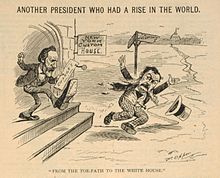
Arthur's four-year term expired on December 10, 1875, and Conkling, now among the most powerful politicians in Washington, arranged his protégé's reappointment by President Grant. By 1876, Conkling was considering a run for the Presidency himself, but the selection of Rutherford B. Hayes, a reformer, at the 1876 Republican National Convention presaged problems for the machine boss. Arthur and the machine gathered campaign funds with their usual zeal, but Conkling limited his own campaign activities to a few speeches. Hayes's opponent, New York Governor Samuel J. Tilden, carried New York, but after the resolution of several months of disputes over twenty electoral votes (from the states of Florida, Louisiana, Oregon, and South Carolina), he lost the Presidency.
Hayes entered office having pledged to reform the patronage system; in 1877, he and Treasury Secretary John Sherman made Conkling's machine their first target. Sherman ordered a commission led by John Jay to investigate the New York Custom House. Jay, with whom Arthur had collaborated in the Lemmon case two decades earlier, suggested that the Custom House was so overstaffed with political appointments that 20% of the employees were expendable. Sherman was less enthusiastic about the reforms than Hayes and Jay, but he approved the commission's report and ordered Arthur to make the personnel reductions. Arthur appointed a committee of Custom House workers to determine where the cuts were to be made and, after a written protest, carried them out. Notwithstanding his cooperation, the Jay Commission issued a second report critical of Arthur and other Custom House employees, and subsequent reports urging a complete reorganization.
Hayes further struck at the heart of the spoils system by issuing an executive order that forbade assessments and barred federal office holders from "tak[ing] part in the management of political organizations, caucuses, conventions, or election campaigns". Arthur and his subordinates, Alonzo B. Cornell and George H. Sharpe, refused to obey the president's order. Sherman encouraged Arthur to resign, offering him the consulship at Paris in exchange, but Arthur refused. In September 1877, Hayes demanded the three men's resignations, which they refused to give. Nonetheless, Hayes submitted appointments of Theodore Roosevelt, Sr., L. Bradford Prince, and Edwin Merritt—all supporters of William M. Evarts, Conkling's New York rival—to the Senate for confirmation as their replacements. The Senate's Commerce Committee, which Conkling chaired, voted unanimously to reject the nominees, and the full Senate rejected Roosevelt and Prince by a vote of 31–25, confirming Merritt only because Sharpe's term had expired.
Arthur's job was thus saved, but only until July 1878 when Hayes took advantage of a Congressional recess to fire him and Cornell, and replace them by recess appointments of Merritt and Silas W. Burt, respectively. Conkling opposed the appointees' confirmation when the Senate reconvened in February 1879, but Merritt was approved by a vote of 31–25, as was Burt by 31–19, giving Hayes his most significant civil service reform victory. After six years, Arthur found himself out of a job, but still a political power. In the state elections of 1879, he and Conkling worked to ensure that the Republican nominees for state offices would be men of Conkling's faction, who had become known as Stalwarts. They were successful, but narrowly, as Cornell was nominated for governor by a vote of 234–216. Arthur and Conkling campaigned vigorously for the Stalwart ticket and, owing partly to a splintering of the Democratic vote, were victorious. Arthur and the machine had rebuked Hayes and their intra-party rivals, but Arthur had had only a few days to enjoy his triumph when, on January 12, 1880, his wife died suddenly while he was in Albany organizing the political agenda for the coming year. He was devastated, and never remarried.
Election of 1880
Conkling and his fellow Stalwarts, including Arthur, wished to follow up their 1879 success at the 1880 Republican National Convention by securing the nomination for their ally, ex-President Grant. Their opponents in the Republican party, known as Half-Breeds, concentrated their efforts on James G. Blaine, a Senator from Maine who was more amenable to civil service reform. Neither candidate commanded a majority of delegates and, deadlocked after thirty-six ballots, the convention turned to a dark horse, James A. Garfield, an Ohio Congressman and Civil War General who was neither Stalwart nor Half-Breed. Garfield and his supporters knew they would face a difficult election without the support of the New York Stalwarts and decided to offer one of them the vice presidential nomination. Levi P. Morton was the first choice of Garfield's supporters but, on Conkling's advice, refused to run. They next approached Arthur. Conkling advised him to also reject the nomination, believing the Republicans would lose. Arthur thought otherwise and accepted, telling Conkling, "The office of the Vice-President is a greater honour than I ever dreamed of attaining." Conkling eventually reconciled himself with the nomination and campaigned for the ticket. As expected, the election was close. The Democratic nominee, General Winfield Scott Hancock, was popular and, since he had not taken unpopular positions (or any positions at all) on the issues of the day, he had not offended any important constituencies. As Republicans had done since the end of the Civil War, Garfield and Arthur initially focused their campaign on the " bloody shirt"—the idea that returning Democrats to office would undo the victory of the Civil War and reward secessionists. With the war fifteen years in the past and Union generals at the head of both tickets, the tactic was less effective than the Republicans hoped. Realizing this, they shifted their approach to claim that Democrats would lower the country's protective tariff, which would allow more cheap manufactured goods to be imported from Europe, thereby putting thousands of workingmen out of work. This argument struck home in the swing states of New York and Indiana, where many were employed in manufacturing. Hancock did not help his own cause when, in an attempt to remain neutral on the tariff, he said that "[t]he tariff question is a local question", which only served to make him appear uninformed about an important issue. Candidates for high office did not personally campaign in those days, but Arthur played a part in the campaign in his usual fashion: raising money. The funds were crucial in the close election, and his home state of New York was pivotal. The Republicans carried New York by 20,000 votes and, in an election with the largest turnout of qualified voters ever recorded—78.4%—they won the nationwide popular vote by just 7,018 votes. The electoral college result was more decisive—214 to 155—and Garfield and Arthur were elected.
Vice Presidency
After the election, Arthur worked to persuade Garfield to fill certain positions—especially that of the Secretary of the Treasury—with his fellow New York Stalwarts. He was unsuccessful, and the Stalwart machine received a further rebuke when they discovered that Garfield planned to appoint Blaine, Conkling's arch-enemy, as Secretary of State. The running mates, never close, grew further apart as Garfield continued to freeze out the Stalwarts from the patronage at his disposal. Arthur's status in the administration fell further when, a month before inauguration day, he gave a speech in front of newspaper reporters that suggested the election in Indiana, a swing state, had been won by illegal voting. Garfield ultimately appointed a Stalwart, Thomas Lemuel James, to be Postmaster General, but the cabinet fight and Arthur's ill-considered speech left the President and Vice President estranged when they took their oaths of office on March 4, 1881. The Senate in the 47th United States Congress was divided among 37 Republicans, 37 Democrats, one independent ( David Davis) who announced he would caucus with the Democrats, one Readjuster ( William Mahone) whose allegiance was uncertain, and four vacancies. Immediately, the Democrats attempted to organize the Senate, knowing that the vacancies would soon be filled by Republicans. As Vice President, Arthur cast tie-breaking votes in favour of the Republicans when Mahone opted to join their caucus. Even so, the Senate remained deadlocked for two months over Garfield's nominations because of Conkling's opposition to some of them. Just before going into recess in May 1881, the situation became more complicated when Conkling and the other Senator from New York, Thomas C. Platt, resigned in protest of Garfield's continuing opposition to their faction.
With the Senate in recess, Arthur had no duties in Washington and returned to New York City. Once there, he traveled with Conkling to Albany, where the former Senator had hoped for a quick re-election to the Senate and, thereby, a rebuke to the Garfield administration. The Republican majority in the state legislature was divided on the question, to Conkling and Platt's surprise, and they found themselves fighting for their political lives. While in Albany on July 2, word reached Arthur that Garfield had been shot. The assassin, Charles J. Guiteau, was a deranged office-seeker who believed that assassinating Garfield would convince Arthur to appoint him to a patronage job; he proclaimed to onlookers: "I am a Stalwart, and Arthur will be President!" Despite his claims of friendship with Arthur, the public soon learned that Guiteau was mentally unstable and unconnected with the Vice President. More troubling was the lack of legal guidance on presidential succession: as Garfield lingered near death, no one was sure who, if anyone, could exercise presidential authority. Moreover, after Conkling's resignation, the Senate had adjourned without electing a president pro tempore, who would normally follow Arthur in the succession. Arthur was reluctant to be seen to act as President while Garfield lived, and the next two months saw a vacuum in the executive office, with Garfield too weak to carry out any of his duties and Arthur refusing to assume them. Through the summer, Arthur refused to travel to Washington and was at his Lexington Avenue home when, on the night of September 19, he learned that Garfield had died. Judge John R. Brady of the New York Supreme Court administered the oath of office in Arthur's home at 2:15 a.m. the following day, and Arthur boarded a train for the nation's capital two days later.
Presidency 1881–1885
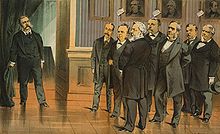
In an 1881 Puck cartoon, Arthur faces the presidential cabinet after President Garfield was shot.
Taking office
Arriving in Washington on September 22, Arthur repeated the oath of office, this time administered by Chief Justice Morrison R. Waite, because of concerns that a state judge may have lacked the authority to administer the presidential oath. He first resided at the home of Senator John P. Jones in anticipation of significant remodeling he had ordered for the White House, including the addition of an elaborate fifty-foot glass screen made by Louis Comfort Tiffany. Since Arthur was a widower, his sister, Mary Arthur McElroy, served as White House hostess. Arthur rapidly became Washington's most eligible bachelor and his social life became the subject of many rumors, but he remained devoted only to the memory of his late wife. His son, Chester Jr., was then a freshman at Princeton University and his daughter, Nell, stayed in New York with a governess until 1882; when she arrived, Arthur attempted to shield her from the intrusions of the press as much as he could.
Arthur quickly came into conflict with Garfield's cabinet, most of whose members represented Republican factions that opposed him. He asked the cabinet members to remain until December, when Congress would reconvene, but Treasury Secretary William Windom submitted his resignation in October to enter a Senate race in his home state of Minnesota. Arthur replaced him with Charles J. Folger, his friend and fellow New York Stalwart. Attorney General Wayne MacVeagh was next to resign, believing that, as a reformer, he had no place in an Arthur cabinet. Despite Arthur's personal appeal to remain, MacVeigh resigned in December 1881 and Arthur replaced him with Benjamin H. Brewster, a Philadelphia lawyer and machine politician who was thought to have some reformist leanings. Blaine, arch-nemesis of the Stalwart faction, agreed to remain Secretary of State until Congress reconvened, and when it did so he departed immediately. Conkling expected Arthur to appoint him in Blaine's place, but the President instead chose Frederick T. Frelinghuysen of New Jersey, a Stalwart recommended by ex-President Grant. Frelinghuysen advised Arthur not to fill any future vacancies with Stalwarts, but when Postmaster General James resigned in January 1882, Arthur selected Timothy O. Howe, a Wisconsin Stalwart, to replace him. Navy Secretary William H. Hunt was next to resign, in April 1882, and Arthur attempted a more balanced approach by appointing William E. Chandler to the post, on Blaine's recommendation. Finally, when Interior Secretary Samuel J. Kirkwood resigned that same month, Arthur appointed Henry M. Teller, a Colorado Stalwart to the office. Of the Cabinet members Arthur had inherited from Garfield, only Secretary of War Robert Todd Lincoln remained for the entirety of Arthur's term.
Civil service reform
In the 1870s, the public became aware of a scandal in which contractors for star postal routes were greatly overpaid for their services with the connivance of government officials (including Second Assistant Postal Secretary Thomas J. Brady and former Senator Stephen Wallace Dorsey). This was an example of the kind of corruption that reformers feared Arthur would permit, and reformers grew concerned that the former supporter of the spoils system would not devote his administration's energy to continuing the investigation into the scandal. Nevertheless, the new Attorney General, Brewster, continued the investigations begun by MacVeigh and hired notable Democratic lawyers William W. Ker and Richard T. Merrick in an attempt both to improve the prosecution team and avoid the appearance of political partisanship. Although Arthur had worked closely with Dorsey before taking office, once in office he supported the investigation and forced the resignation of officials suspected in the scandal. An 1882 trial of the ringleaders resulted in convictions for two minor conspirators and a hung jury for the rest. After a juror came forward with allegations that the defendants attempted to bribe him, the judge set aside the guilty verdicts and granted a new trial. Before the second trial began, Arthur removed five federal office holders who were sympathetic with the defense, including a former Senator. The second trial began in December 1882 and lasted until July 1883 and, again, did not result in a guilty verdict. Failure to obtain a conviction tarnished the administration's image, but Arthur did succeed in putting a stop to the fraud.
Garfield's assassination by a deranged office seeker amplified the growing public demand for civil service reform. Democratic and Republican leaders both realized that they could attract the votes of reformers by turning against the spoils system and, by 1882, the tide turned in favour of reform. As early as 1880, Democratic Senator George H. Pendleton of Ohio had introduced legislation that would allow for selection of civil servants based on merit as determined by an examination. In his first annual Presidential address to Congress in 1881, Arthur requested civil service reform legislation and Pendleton again introduced his bill, but Congress did not pass it. Republicans lost seats in the 1882 congressional elections, in which Democrats campaigned on the reform issue. As a result, the lame duck session of Congress was more amenable to civil service reform; the Senate approved Pendleton's bill 38–5 and the House soon concurred by a vote of 155–47. Arthur signed the Pendleton Civil Service Reform Act into law on January 16, 1883. In just two years' time, an unrepentant Stalwart had become the president who ushered in long-awaited civil service reform.
At first, the act applied only to 10% of federal jobs and, without proper implementation by the president, it could have gone no further. Even after he signed the act into law, its proponents doubted Arthur's commitment to reform. To their surprise, he acted quickly to appoint the members of the Civil Service Commission that the law created, naming reformers Dorman Bridgeman Eaton, John Milton Gregory, and Leroy D. Thoman as commissioners. The chief examiner, Silas W. Burt, was a long-time reformer who had been Arthur's opponent when the two men worked at the New York Customs House. The commission issued its first rules in May 1883; by 1884, half of all postal officials and three-quarters of the Customs Service jobs were to be awarded by merit. That year, Arthur expressed satisfaction in the new system, praising its effectiveness "in securing competent and faithful public servants and in protecting the appointing officers of the Government from the pressure of personal importunity and from the labor of examining the claims and pretensions of rival candidates for public employment."
Surplus and the tariff
With high income held over from wartime taxes, the federal government had collected more revenue than it had spent since 1866 and, by 1882, the surplus had reached $145 million. Opinions varied on how to balance the budget. Most Democrats wished to lower tariffs, in order to reduce revenues and lower the cost of imported goods. Republicans largely disagreed, believing that high tariffs ensured high wages for men employed in manufacturing and natural resource extraction. They preferred that the government spend more on internal improvements and reduce excise taxes. Arthur mostly agreed with his party, and in 1882 called for the abolition of excise taxes on everything except liquor, as well as a simplification of the complex tariff structure. In May of that year, Representative William D. Kelley of Pennsylvania introduced a bill to establish a tariff commission. The bill passed and Arthur signed it into law but appointed mostly protectionists to the committee. Republicans were pleased with the committee's make-up but were surprised when, in December 1882, they submitted a report to Congress calling for tariff cuts averaging between 20 and 25%. The commission's recommendations were ignored, however, as the House Ways and Means Committee, dominated by protectionists, wrote the law to yield reductions of 10%. After conference with the Senate, the bill that emerged only reduced tariffs by an average of 1.47%. The bill passed both houses narrowly on March 3, 1883, the last full day of the 47th Congress. Arthur signed the measure into law, but it did little to reduce the surplus.
At the same time and closely tied to the tariff and budget debate, Congress attempted to balance the budget from the other side of the ledger by spending on the 1882 Rivers and Harbors Act that contained the then-unprecedented expenditure of $19 million for internal improvements. While Arthur was not opposed to internal improvements, the scale of the bill disturbed him, as did its focus on "particular localities," rather than on projects that benefited a large part of the nation. On August 1, 1882, Arthur vetoed the bill to widespread popular acclaim. In his veto message, he wrote that his principal objection to the bill was that it appropriated funds for purposes "not for the common defense or general welfare, and which do not promote commerce among the States." Congress overrode his veto the next day and the new law reduced the surplus by $19 million. Many Republicans considered the law a success at the time, but later believed the unpopular law contributed to their loss of seats in the elections of 1882.
Foreign affairs and immigration
During the Garfield administration, Secretary of State James G. Blaine took the United States' diplomacy in Latin America in a new direction, urging reciprocal trade agreements and offering to mediate disputes among the Latin American nations. Blaine proposed holding a Pan-American conference in 1882 to discuss trade and an end to the War of the Pacific being fought by Bolivia, Chile, and Peru. This represented a greater involvement in affairs south of the Rio Grande than the United States had previously attempted, and marked a significant shift in foreign policy. Blaine did not remain in office long enough to see the effort through, and when Frederick T. Frelinghuysen replaced him at the end of 1881, the conference efforts lapsed. Frelinghuysen also discontinued Blaine's peace efforts in the War of the Pacific, fearing that the United States might be drawn into the conflict. Arthur and Frelinghuysen continued Blaine's efforts to encourage trade among the nations of the Western Hemisphere, and a treaty with Mexico providing for reciprocal tariff reductions was signed in 1882 and approved by the Senate in 1884. The House declined to approve the legislation required to bring the treaty into force, however, rendering it a dead letter. Similar efforts at reciprocal trade treaties with Santo Domingo and Spain's American colonies were defeated by February 1885, and an existing reciprocity treaty with the Kingdom of Hawaii was allowed to lapse.
The 47th Congress spent a great deal of its time on the regulation of immigration, at times in accord with Arthur's wishes and at times against them. In July 1882, without significant opposition, Congress passed a bill regulating steamships that carried immigrants to the United States. To their surprise, Arthur vetoed it, citing problems in the bill's wording; Congress agreed to reword it, and he signed the revised measure. He also signed in August of that year the Immigration Act of 1882, which levied a 50-cent tax on immigrants to the United States, as well as excluding from entry the mentally ill, the mentally retarded, criminals, or any person "unable to take care of himself or herself without becoming a public charge." A larger debate concerned the status of one particular group of immigrants: the Chinese. In 1868, the Senate had ratified the Burlingame Treaty with China, allowing an unrestricted flow of Chinese immigrants into the country. As the economy soured after the Panic of 1873, Chinese immigrants were blamed for depressing workmen's wages. In response, Congress passed a Chinese Exclusion Act in 1879, abrogating the 1868 treaty, which President Hayes vetoed. Three years later, after China had agreed to treaty revisions, Congress tried again to exclude Chinese immigrants. Senator John F. Miller of California introduced a Chinese Exclusion Act that would have denied Chinese immigrants United States citizenship and completely banned their immigration for the next twenty years. The bill passed the Senate and House by overwhelming margins, arriving at Arthur's desk in April 1882. Arthur vetoed the bill, seeing the 20-year ban as a breach of the renegotiated treaty of 1880, which allowed only a "reasonable" suspension of immigration. Eastern newspapers praised the veto, but he was widely condemned in the Western states. Congress was unable to override the veto, instead passing a new bill that reduced the ban on Chinese immigration to ten years. Although he still objected to the denial of citizenship to Chinese immigrants, Arthur signed the compromise measure into law on May 6, 1882.
In the years following the Civil War, American naval power declined precipitously, shrinking from nearly 700 vessels to just 52, most of which were obsolete. The nation's military focus over the fifteen years before Garfield and Arthur's election had been on the Indian wars in the West, rather than the high seas, but as the region was increasingly pacified, many in Congress grew concerned at the poor state of the Navy. Garfield's Secretary of the Navy, William H. Hunt, advocated reform of the Navy and his successor, William E. Chandler, appointed an advisory board to prepare a report on modernization. Based on the suggestions in the report, Congress appropriated funds for the construction of three steel protected cruisers ( Atlanta, Boston, and Chicago) and an armed dispatch-steamer ( Dolphin), collectively known as the "ABCD Ships" or the " Squadron of Evolution". Congress also approved funds to rebuild four monitors ( Puritan, Amphitrite, Monadnock, and Terror,) which had lain uncompleted since 1877. The contracts to build the ABCD ships were all awarded to the low bidder, John Roach & Sons of Chester, Pennsylvania, even though Roach once employed Secretary Chandler as a lobbyist. Democrats turned against the "New Navy" projects and, when they won control of the 48th Congress, refused to appropriate funds for seven more steel warships. Even without the additional ships, the state of the Navy improved when, after several construction delays, the last of the new ships entered service in 1889.
Civil rights
Like his Republican predecessors, Arthur struggled with the question of how his party was to challenge the Democrats in the South and how, if at all, to protect the civil rights of black southerners. Since the end of Reconstruction, conservative white Democrats (or " Bourbon Democrats") had regained power in the South, and the Republican party dwindled rapidly as their primary supporters in the region, blacks, were disenfranchised. One crack in the solidly Democratic South emerged with the growth of a new party, the Readjusters, in Virginia. Having won an election in that state on a platform of more education funding (for black and white schools alike) and abolition of the poll tax and the whipping post, many northern Republicans saw the Readjusters as a more viable ally in the South than the moribund southern Republican party. Arthur agreed, and directed the federal patronage in Virginia through the Readjusters rather than the Republicans. He followed the same pattern in other Southern states, forging coalitions with independents and Greenback Party members. Some black Republicans felt betrayed by the pragmatic gambit, but others (including Frederick Douglass and ex-Senator Blanche K. Bruce) endorsed the administration's actions, as the Southern independents had more liberal racial policies than the Democrats. Arthur's coalition policy was only successful in Virginia, however, and by 1885 the Readjuster movement began to collapse with the election of a Democratic president. Other federal action on behalf of blacks was equally ineffective: when the Supreme Court struck down the Civil Rights Act of 1875 in an 1883 decision, Arthur expressed his disagreement with the decision in a message to Congress, but was unable to persuade Congress to pass any new legislation in its place. Arthur did, however, effectively intervene to overturn a court-martial ruling against a black West Point cadet, Johnson Whittaker, after the Judge Advocate General of the Army, David G. Swaim, found the prosecution's case against Whittaker legally invalid and based on racial animus. The administration faced a different challenge in the West, where the LDS Church was under government pressure to stop the practice of polygamy in Utah Territory. Garfield had believed polygamy was criminal behaviour and was morally detrimental to family values, and Arthur's views were, for once, in line with his predecessor's. In 1882, he signed the Edmunds Act into law, making polygamy a federal crime and barring polygamists from public office.
Indian policy
The Arthur administration also dealt with changing relations with western American Indian tribes. The Indian Wars were winding down, and public sentiment was shifting toward more favorable treatment of Native Americans. Arthur urged Congress to increase funding for Indian education, which it did in 1884, although not to the extent he wished. He also favored a move to the allotment system, under which individual Native Americans, rather than tribes, would own land. Arthur was unable to convince Congress to adopt the idea during his administration but, in 1887, the Dawes Act changed the law to favour such a system. The allotment system was favored by liberal reformers at the time, but eventually proved detrimental to Native Americans as most of their land was resold at low prices to white speculators. During Arthur's presidency, settlers and cattle ranchers continued to encroach on Indian territory. Arthur initially resisted their efforts, but after Secretary of the Interior Henry M. Teller, an opponent of allotment, assured him that the lands were not protected, Arthur opened up the Crow Creek Reservation in the Dakota Territory to settlers by executive order in 1885. Arthur's successor, Grover Cleveland, finding that title belonged to the Indians, revoked Arthur's order a few months later.
Health, travel, and renomination
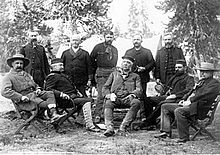
Shortly after becoming President, Arthur was diagnosed with Bright's disease, a kidney ailment now referred to as nephritis. He attempted to keep his condition private, but by 1883 rumors of his illness began to circulate. By that time he had become thinner and more aged in appearance, as well as less energetic in keeping up with the demands of the presidency. Hoping to rejuvenate his health by getting out of Washington, Arthur and some political friends traveled to Florida in April 1883. The vacation had the opposite effect, and Arthur suffered from intense pain before returning to Washington. Later that year, on the advice of Missouri Senator George Graham Vest, he visited Yellowstone National Park. Reporters accompanied the presidential party, helping to publicize the new National Park system. The Yellowstone trip was more beneficial to Arthur's health than his Florida excursion, and he returned to Washington refreshed after two months of travel.
As the 1884 presidential election approached, James G. Blaine was thought to be the favorite for the Republican nomination, but Arthur, too, contemplated a run for a full term as President. In the months leading up to the 1884 Republican National Convention, however, Arthur began to realize that neither faction of the Republican party was prepared to give him their full support: the Half-Breeds were again solidly behind Blaine, while Stalwarts were undecided; some backed Arthur, with others considering Senator John A. Logan of Illinois. Reform-minded Republicans, friendlier to Arthur after he endorsed civil service reform, were still not certain enough of his reform credentials to back him over Senator George F. Edmunds of Vermont, who had long favored their cause. Business leaders supported him, as did Southern Republicans who owed their jobs to his control of the patronage, but by the time they began to rally around him, Arthur had decided against a serious campaign for the nomination. He kept up a token effort, believing that to drop out would cast doubt on his actions in office and raise questions about his health, but by the time the convention began in June, his defeat was almost assured. Blaine led on the first ballot, and by the fourth ballot he had a majority. Arthur telegraphed his congratulations to Blaine and accepted his defeat with equanimity. He played no role in the 1884 campaign, which Blaine would later say contributed to his loss that November to the Democratic nominee, Grover Cleveland.
Administration and cabinet
| The Arthur Cabinet | ||
|---|---|---|
| Office | Name | Term |
| President | Chester A. Arthur | 1881–1885 |
| Vice President | None | 1881–1885 |
| Secretary of State | James G. Blaine | 1881 |
| Frederick T. Frelinghuysen | 1881–1885 | |
| Secretary of Treasury | William Windom | 1881 |
| Charles J. Folger | 1881–1884 | |
| Walter Q. Gresham | 1884 | |
| Hugh McCulloch | 1884–1885 | |
| Secretary of War | Robert T. Lincoln | 1881–1885 |
| Attorney General | Wayne MacVeagh | 1881 |
| Benjamin H. Brewster | 1881–1885 | |
| Postmaster General | Thomas L. James | 1881 |
| Timothy O. Howe | 1881–1883 | |
| Walter Q. Gresham | 1883–1884 | |
| Frank Hatton | 1884–1885 | |
| Secretary of the Navy | William H. Hunt | 1881–1882 |
| William E. Chandler | 1882–1885 | |
| Secretary of the Interior | Samuel J. Kirkwood | 1881–1882 |
| Henry M. Teller | 1882–1885 | |
Judicial appointments
Arthur made appointments to fill two vacancies on the United States Supreme Court. The first vacancy arose in July 1881 with the death of Associate Justice Nathan Clifford, a Democrat who had been a member of the Court since before the Civil War. Arthur nominated Horace Gray, a distinguished jurist from the Massachusetts Supreme Judicial Court to replace him, and the nomination was easily confirmed. Gray would serve until 1902 and was the author of the court's majority opinion in United States v. Wong Kim Ark, which overturned the section of the Chinese Exclusion Act that denied Chinese-Americans citizenship. The second vacancy occurred when Associate Justice Ward Hunt retired in January 1882. Arthur first nominated his old political boss, Roscoe Conkling; he doubted that Conkling would accept, but felt obligated to offer a high office to his former patron. The Senate confirmed the nomination but, as expected, Conkling declined it, the last time a confirmed nominee declined his appointment. Senator George Edmunds was Arthur's next choice, but he declined to be considered. Instead, Arthur nominated Samuel Blatchford, who had been a judge on the Second Circuit Court of Appeals for the prior four years. Blatchford accepted, and his nomination was approved within two weeks. Blatchford served on the Court until his death in 1893.
Retirement, death, and memorials
Arthur left office in 1885 and returned to his New York City home. Two months before the end of his term, several New York Stalwarts approached him to request that he run for United States Senate, but he declined, preferring to return to his old law practice at Arthur, Knevals & Ransom. His health limited his activity with the firm, and Arthur served only of counsel. He took on few assignments with the firm and was often too ill to leave his house. He managed a few public appearances, up until the end of 1885.
After summering in New London, Connecticut, in 1886, he returned quite ill and, on November 16, ordered nearly all of his papers, both personal and official, burned. The next morning, Arthur suffered a cerebral hemorrhage and never regained consciousness; he died the following day at the age of 57. On November 22, a private funeral was held at the Church of the Heavenly Rest in New York City, attended by President Cleveland and ex-President Hayes, among other notables. Arthur was buried next to the graves of many of his family members and ancestors in the Albany Rural Cemetery in Menands, New York. He was laid beside his wife in a sarcophagus on a large corner of the plot. In 1889, a monument was placed on Arthur's burial plot by sculptor Ephraim Keyser of New York, consisting of a giant bronze female angel figure placing a bronze palm leaf on a granite sarcophagus.
In 1898, the Arthur memorial statue—a fifteen-foot, bronze figure of Arthur standing on a Barre granite pedestal—was created by sculptor George Edwin Bissell and installed at Madison Square, in New York City. The statue was dedicated in 1899 and unveiled by Arthur's sister, Mary Arthur McElroy. At the dedication, Secretary of War Elihu Root described Arthur as "wise in statesmanship and firm and effective in administration", while acknowledging that Arthur was isolated in office and unloved by his own party. Critics at the time viewed Arthur as a playboy who did not take the Presidency seriously.
Arthur's unpopularity in life carried over into his assessment by historians, and his reputation after leaving office disappeared. By 1935, historian George F. Howe said that Arthur had achieved "an obscurity in strange contrast to his significant part in American history." By 1975, however, Thomas C. Reeves would write that Arthur's "appointments, if unspectacular, were unusually sound; the corruption and scandal that dominated business and politics of the period did not tarnish his administration." As 2004 biographer Zachary Karabell wrote, although Arthur was "physically stretched and emotionally strained, he strove to do what was right for the country."
